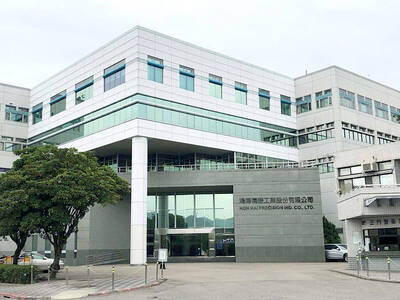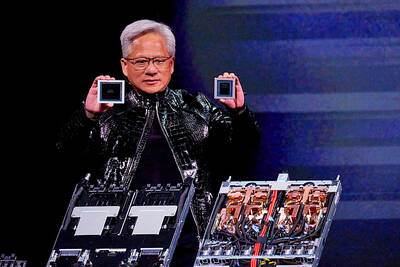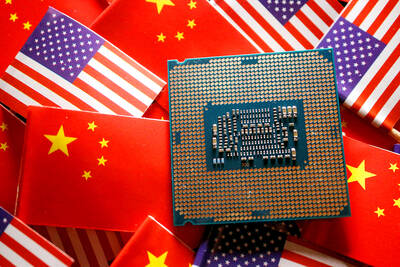Asustek Computer Inc (華碩), the world’s No. 5 PC brand, yesterday said that it plans to introduce two more wearable devices in the second half of next year, seeking to repeat the success of the smartwatch it launched recently in a bid to become one of the world’s top three suppliers of wearable devices.
Asustek’s ZenWatch has been rolled out ahead of Apple Inc’s Apple Watch, which is expected to hit the market early next year.
“ZenWatch is our first wearable device powered by Goolge Inc’s Android Wear system,” Asustek chief executive Jerry Shen (沈振來) said at a product launch for the local market, following the smart device’s overseas debut.

Photo: CNA
Shen said the market reactions to the ZenWatch in the US and Japan have been satisfying. He declined to disclose sales figures.
“Select European countries, China and Hong Kong will be included in the second wave of ZenWatch launches,” he added.
The company said that supplies of the smart device are running short in the US and Japan, which Shen attributed to a components shortage.
Asustek only utilizes 50 percent of its 50,000 units-a-month capacity.
The supply shortage could extend to February next year, Shen said.
Despite this, Asustek is planning to launch the second-generation ZenWatch — which has a voice call function and a smart wristband — in the third quarter of next year.
Asustek hopes that the device, which is priced at NT$5,990, gains popularity in the mass market. That figure is almost half of Apple Watch’s price tag of at least US$349.
Since smartwatches are the first Internet of Things product with foreseeable growth potential, Asustek will strive to become “a key player” in this sector, Shen said.
The company is to boost ZenWatch production in the second half of next year, either to produce the first-generation models, or the second-generation ones, Shen said.
Separately, Shen said that “the weak yen has not affected the revenue ZenWatch has generated for Asustek because the product was launched in Japan in November and the currency appears to have stopped falling since then.”
Asustek’s share price closed down 0.88 percent at NT$337 yesterday, underperforming the TAIEX, which gained 0.97 percent.

Shares in Taiwan closed at a new high yesterday, the first trading day of the new year, as contract chipmaker Taiwan Semiconductor Manufacturing Co (TSMC, 台積電) continued to break records amid an artificial intelligence (AI) boom, dealers said. The TAIEX closed up 386.21 points, or 1.33 percent, at 29,349.81, with turnover totaling NT$648.844 billion (US$20.65 billion). “Judging from a stronger Taiwan dollar against the US dollar, I think foreign institutional investors returned from the holidays and brought funds into the local market,” Concord Securities Co (康和證券) analyst Kerry Huang (黃志祺) said. “Foreign investors just rebuilt their positions with TSMC as their top target,

REVENUE PERFORMANCE: Cloud and network products, and electronic components saw strong increases, while smart consumer electronics and computing products fell Hon Hai Precision Industry Co (鴻海精密) yesterday posted 26.51 percent quarterly growth in revenue for last quarter to NT$2.6 trillion (US$82.44 billion), the strongest on record for the period and above expectations, but the company forecast a slight revenue dip this quarter due to seasonal factors. On an annual basis, revenue last quarter grew 22.07 percent, the company said. Analysts on average estimated about NT$2.4 trillion increase. Hon Hai, which assembles servers for Nvidia Corp and iPhones for Apple Inc, is expanding its capacity in the US, adding artificial intelligence (AI) server production in Wisconsin and Texas, where it operates established campuses. This

Nvidia Corp chief executive officer Jensen Huang (黃仁勳) on Monday introduced the company’s latest supercomputer platform, featuring six new chips made by Taiwan Semiconductor Manufacturing Co (TSMC, 台積電), saying that it is now “in full production.” “If Vera Rubin is going to be in time for this year, it must be in production by now, and so, today I can tell you that Vera Rubin is in full production,” Huang said during his keynote speech at CES in Las Vegas. The rollout of six concurrent chips for Vera Rubin — the company’s next-generation artificial intelligence (AI) computing platform — marks a strategic

US President Donald Trump on Friday blocked US photonics firm HieFo Corp’s US$3 million acquisition of assets in New Jersey-based aerospace and defense specialist Emcore Corp, citing national security and China-related concerns. In an order released by the White House, Trump said HieFo was “controlled by a citizen of the People’s Republic of China” and that its 2024 acquisition of Emcore’s businesses led the US president to believe that it might “take action that threatens to impair the national security of the United States.” The order did not name the person or detail Trump’s concerns. “The Transaction is hereby prohibited,”